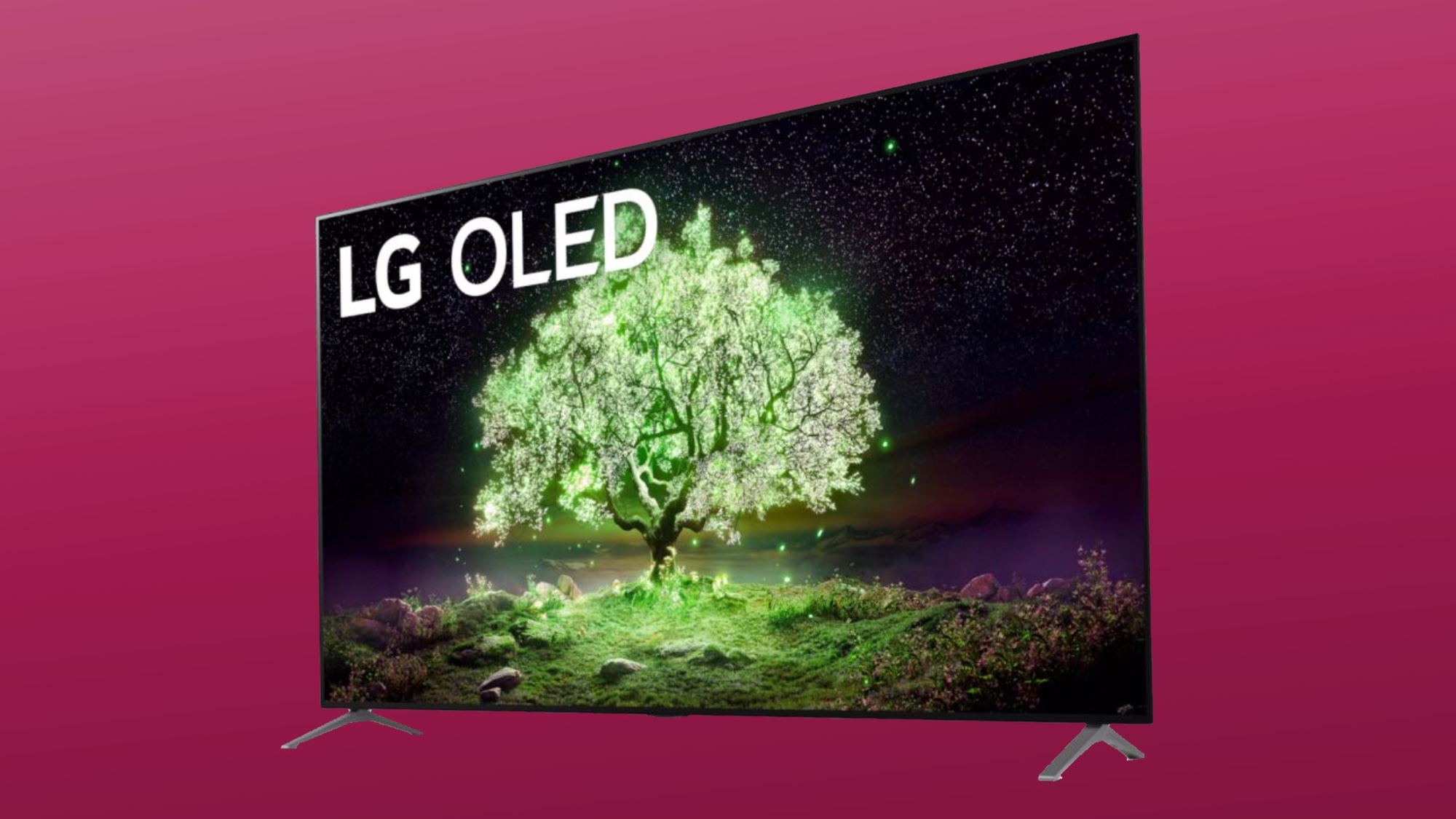LG A1 OLED TV looks cheap — but is it a good value?
LG's new entry-level OLED is affordable, but it might not be everything we'd hoped for

LG's entry level A1 OLED is a new line, designed specifically to create a lower-tier version of LG's normally premium 4K OLED smart TVs. And to do this, LG has adjusted the feature set to better distinguish it from more expensive sets like the LG C1 and G1 OLEDs.
But as I looked over the specs and features of the A1 OLED models, a creeping suspicion left me wondering what the overall value of these less-expensive OLED TVs would be once we knew everything. Would it be a more affordable version of LG's superb OLED TVs? Or would it feel less like an LG OLED TV at a cheaper price and more like LG putting its OLED panels into a cheap TV?
Well, we finally have LG's 2021 OLED TV pricing and I'm afraid it's the latter.
- The best TVs you can buy now
- OLED vs QLED: What TV tech is better?
The new LG A1 OLED will start at $1,299 for a 48-inch model, steps up to $1,599 for a 55-inch, $2,199 for a 65-inch model and tops out at $3,199 for the largest 77-inch screen size. (For a deeper look at pricing, features and how they stack up, check out LG 2021 OLED TVs compared: Which one should you buy?)
Now let me say upfront, cheaper OLED TVs are a great thing. The quality of OLED is undeniable, and LG has effectively cornered this market by being the source of pretty much every OLED TV panel out there, including the OLED TVs from Sony and Vizio. And OLED technology promises great picture quality regardless; the nature of the technology allows for superb black levels, excellent per-pixel backlight control and gorgeous picture all around.
Well, the prices for the A1 OLED TV are definitely lower than other OLED models in the LG lineup, but maybe not as low as we had hoped. And maybe not with the value people have associated with OLED for so long.
Why the LG A1 OLED TV is so cheap
Lets rundown what LG did to differentiate the A1 OLED from it's more premium models.
Get instant access to breaking news, the hottest reviews, great deals and helpful tips.
| Header Cell - Column 0 | LG G1 OLED | LG C1 OLED | LG A1 OLED |
|---|---|---|---|
| Panel type | OLED evo Display | OLED 4K | OLED 4K |
| Refresh rate | 120Hz | 120Hz | 60Hz |
| Processor | α9 Gen 4 | α9 Gen 4 | α7 Gen 4 |
| Audio | 4.2 Ch / 60W | 2.2 Ch / 40W | 2.0 Ch / 20W |
| HDMI ports | 4 HDMI 2.1 | 4 HDMI 2.1 | 3 HDMI 2.0 |
The panel looks like it's the same 4K OLED panel seen in the LG C1 OLED, which should be great, if past performance is any indication. But the refresh rate is lower, opting for 60Hz instead of the 120Hz that the C1 OLED can do. Is that a difference in panel quality, or a change on the processing side that limits it to the lower refresh rate? I'm not sure. In any case, that won't be a huge deal, since the vast majority of content tops out at 60Hz or lower, and even gaming (one area where higher frame rates are now supported) will still be fully playable at that frame rate.
The processor is a step down, with the A1 OLED being outfitted with LG's Alpha 7 Gen 4 chip instead of the Alpha 9 option used on the C1 and G1 OLEDs. Since that processor will impact everything from upscaling and motion handling to smart functions, it could result in all sorts of small performance differences. We'll have to wait for testing and review to know for sure how it stacks up against the more premium OLEDs.
LG A1 OLED audio, ports and design
The audio, on the other hand, is a different story. Instead of the powerful, multi-channel sound that you'll get on more expensive models, the LG A1 has only stereo speakers built in, and they're relatively weak with just 20 watts of power. This is one set where you'll definitely want to supplement with one of the best soundbars.
The port selection also takes a hit. Instead of 4 HDMI ports, the A1 OLED gets just three. That's still enough for, say, a cable or satellite box, a Blu-ray player and a game console. But what if you have two game consoles? Or an Apple TV or Roku streaming stick for accessing an app or show that LG doesn't have access to? Expect more plugging and unplugging things by hand now that you have one less port. (See why we recommend more ports in our TV buying guide.)
And even though every 2020 LG OLED boasted HDMI 2.1, the newest OLED line is stuck with HDMI 2.0. While that's a perfectly serviceable standard – and it's the one you'll find on most 2020 TVs of every type and price range – it is a glaring step down when it comes to gaming. The newer HDMI 2.1 standard supports variable refresh rates (VRR) and support for PC gaming with Nvidia G-Sync and AMD FreeSync, the HDMI 2.0 standard does not. And which standard do the new PS5 and Xbox Series X use? Yup, HDMI 2.1.
You will get support for auto low-latency mode (ALLM) which switches to game mode when your console fires up a game, but the other conveniences offered by 2.1 connectivity just aren't supported.
Finally, there's the design. Instead of LG's sleek display-on-glass design, or the elegant pedestal base that LG's CX and BX OLED TVs had, the A1 OLED has a decidedly more pedestrian look to it, with detachable plastic feet and a less polished cabinet design.
LG A1 OLED vs other cheap OLED TVs
Add up all the little downgrades, and the A1 OLED still sounds like a great bargain, but one that you'll notice the compromises in far more readily than even other affordable OLED TVs.
Personally, I had hoped for something of a middle ground between entry-level and cheap. I'm fine with a cheaper TV design. Plastic construction and an average looking stand shouldn't dissuade anybody from buying the A1 if they really want an OLED TV.
But the lower grade processing and port selection rub me the wrong way. Not because they're unacceptable — there are plenty of TVs on the market with HDMI 2.0 ports and only three ports total, and LG's processing technology should be above average even at this lower price point and lower power.
Comparing the 2021 A1 OLED to 2020's most affordable OLED sets, it is a letdown. The LG BX OLED (which the A1 doesn't exactly replace, but which was LG's "entry-level OLED line" last year) sells for less than the A1 OLED will, with a 55-inch model retailing now for $1,299, the same price as the smaller 48-inch A1 OLED. And the BX has two HDMI 2.1 ports along with two HDMI 2.0 ports, offering notably better connectivity. The overall design is better, too. In fact, it was so similar to the more-premium LG CX OLED that our review openly worries about shoppers confusing the two.
The newcomer in OLED TVs, the Vizio OLED TV (OLED55-H1) also had a better design, and matched the A1 OLED's features in most respects, but with a beefier 30-watt sound system. The only significant difference that plays to the LG A1's strengths is that the Vizio OLED TV uses that manufacturer's proprietary SmartCast software, and LG uses webOS, which used to be an LG exclusive, but will be showing up on more TVs this year thanks to a new licensing deal from LG.
And guess what? Yup, the Vizio is also cheaper than the A1 OLED, with a 55-inch model selling for $1,299 (less during sales events), while the 55-inch A1 OLED will be $1,599 when it launches in April.
Finally, a lot of people were hoping that the A1 would be not merely an affordable OLED TV, but an accessible way for gamers to get in on the benefits of OLED without having to spend a fortune. You can definitely enjoy games on the A1 OLED, but you can't get all of the convenience features of HDMI 2.1 (like VRR) and you'll be limited to 60Hz refresh rates, even on games that will support up to 120Hz.
Without testing, we simply don't know enough about lag times and motion handling to actually say how well the A1 OLED will perform as a gaming TV. But we know that out of the box it will be a less capable gaming TV than other affordable OLED TVs already on the market, like last year's LG BX OLED.
There's still hope, if you're patient
The saving grace for the LG A1 OLED TV is likely to be the price, simply because TV prices are not static throughout the year. The prices seen when a TV launches in the spring are not the prices that TV will be selling at come fall, and if you are a bargain hunter watching for deals around Black Friday and the holidays, those prices are even lower.
Could the LG A1 OLED TV still wind up being the first OLED to sell for less than $1,000? Yes, but not right away. And with other TVs already hitting these price points during sales events, the A1 OLED may just wind up being one of several affordable OLED options, and a less impressive one at that.
Suffice it to say that my high hopes for LG's affordable OLED TV aren't quite as high as they once were. And with competitors staking out the same entry-level territory with arguably better OLED TVs, shouldn't LG be a little more worried?
Brian Westover is currently Lead Analyst, PCs and Hardware at PCMag. Until recently, however, he was Senior Editor at Tom's Guide, where he led the site's TV coverage for several years, reviewing scores of sets and writing about everything from 8K to HDR to HDMI 2.1. He also put his computing knowledge to good use by reviewing many PCs and Mac devices, and also led our router and home networking coverage. Prior to joining Tom's Guide, he wrote for TopTenReviews and PCMag.

